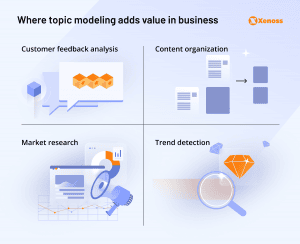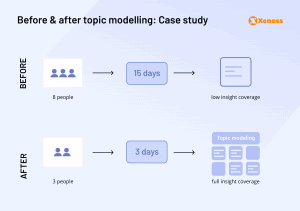This is part 3 of our 3-part series on topic modeling for business applications. Part 1 explored topic modeling and how it differs from classification and clustering. Part 2 compared different topic modeling approaches. In this final article, we showcase real-world business applications and case studies.
Real-world topic modeling applications
The theory and mechanics of topic modeling provide a strong foundation, but where these techniques truly shine is in real-world applications. Organizations across industries are leveraging topic modeling to transform mountains of unstructured text data into actionable business intelligence.
In this final installment of our series, we’ll explore concrete business applications and case studies that demonstrate how topic modeling delivers tangible value across various domains. From analyzing customer feedback to organizing content, conducting market research, and detecting emerging trends, you’ll discover how leading organizations apply these techniques to solve complex business challenges.
By examining these real-world implementations, you’ll gain insights into how your organization can leverage topic modeling to unlock the hidden value in your unstructured text data and drive more informed business decisions.

Customer feedback analysis
Perhaps one of the most powerful applications of topic modeling is understanding what customers say about products and services. Manual analysis becomes practically impossible when faced with thousands or even millions of customer reviews, surveys, and support tickets.
A compelling example comes from a major European insurance provider who partnered with Xenoss to transform their customer feedback analysis. Despite collecting over 100 million feedback ratings across various channels over three years, the insurer couldn’t extract meaningful insights from their data. Only 12% of ratings included text comments; most were emotionally charged statements like “Issue not resolved!” without clear actionable information.
Their manual review process had become a bottleneck—eight employees needed 15 days to analyze just 1,500-2,000 feedback entries. Xenoss transformed this process by developing an AI-powered solution using advanced topic modeling techniques, including LDA and BERTopic, alongside sentiment analysis.
The results were remarkable: The processing time dropped from 15 to just 3 days, while the required personnel decreased from eight to three. Most impressively, the system could now handle unlimited feedback entries with complete coverage across all channels and products.
What made this transformation possible? Xenoss implemented a sophisticated multi-stage approach combining transformer-based language models with HDBSCAN clustering to identify high-density regions within the document space. This enabled the automatic detection of hidden patterns and emerging issues that human reviewers had missed.
If you’re interested in learning more about the technical architecture, implementation details, and how they achieved 82% topic accuracy while discovering more issues than human experts could identify, contact our team to discuss how a similar solution could work for your organization.
Content organization and discovery
Libraries, media companies, and content providers face the challenge of organizing vast repositories of documents, articles, and resources in ways that make them discoverable. Traditional categorization methods often fall short as content collections grow.
Topic modeling excels in this area by automatically identifying thematic patterns across documents. News organizations use these techniques to categorize articles by subject matter, enabling more intuitive navigation for readers. Digital asset managers employ topic modeling to organize multimedia content based on descriptions and metadata, making previously buried content discoverable again.
The power of this approach lies in its ability to work with minimal human intervention. As new content is created, topic models can automatically categorize it according to existing themes or identify emerging topics that suggest the need for new categories.
Market research applications
Market researchers have embraced topic modeling as an essential tool for understanding consumer sentiment and market trends. By analyzing social media conversations, product reviews, and forum discussions, companies gain insights into how consumers perceive their brands and products.
These techniques allow researchers to move beyond simple sentiment analysis (positive/negative) to understand the specific topics driving consumer opinions. For example, a smartphone manufacturer might discover that positive sentiment is linked to battery life and camera quality, while negative sentiment centers on price and software issues.
Topic modeling also helps identify emerging market trends before they become obvious. By detecting subtle shifts in conversation topics across social platforms, companies can identify changing consumer priorities or emerging product categories before their competitors.
Trend detection and monitoring
The ability to detect trends over time represents one of the most valuable applications of topic modeling. Organizations gain powerful predictive capabilities by tracking how topics emerge, evolve, and fade across chronologically ordered datasets.
How businesses turn unstructured text into insights
Financial institutions use topic modeling to analyze news articles, reports, and social media to identify subtle shifts that might impact markets. Healthcare organizations monitor medical literature to track the emergence of new treatment approaches or evolving understanding of disease mechanisms.
The effectiveness of trend detection improves with the integration of multiple-topic modeling approaches. While LDA excels at identifying established topics with clear boundaries, embedding-based models like Top2Vec and BERTopic often perform better at detecting nascent topics with less established vocabulary.
B2B SaaS companies also use topic modeling to track shifts in how competitors position their offerings or to detect early interest in adjacent product categories before market saturation.
For organizations seeking to stay ahead of change in their industry, implementing a systematic approach to topic modeling provides an invaluable competitive advantage—transforming the overwhelming noise of digital conversation into clear signals that drive strategic decision-making.
Whether you’re dealing with customer feedback like the European insurance provider in Xenoss’s case study (request a full case study version by filling out the form), organizing content repositories, conducting market research, or monitoring industry trends, topic modeling techniques can help convert unstructured text into structured insights that drive better business decisions.

Final thoughts
As unstructured text data continues to proliferate across business environments, topic modeling has evolved from an academic curiosity to an essential component of modern business intelligence.
The most successful organizations recognize that no single approach—whether traditional LDA or cutting-edge BERTopic—offers a complete solution; rather, they strategically combine multiple techniques while integrating topic modeling into their broader data infrastructure.
Looking ahead, we anticipate further advancements as these models incorporate multimodal capabilities and improved handling of multilingual content, offering even greater potential for transforming textual chaos into actionable insights. Organizations that master these techniques today position themselves to extract maximum value from their text data tomorrow, gaining significant competitive advantage in an increasingly data-driven business landscape.
This concludes our 3-part series on topic modeling for business applications. To review the foundations, visit part 1: Topic modeling for business, introduction, and key distinctions. For a comparison of different modeling approaches, see part 2: Comparing topic modeling approaches for business applications.